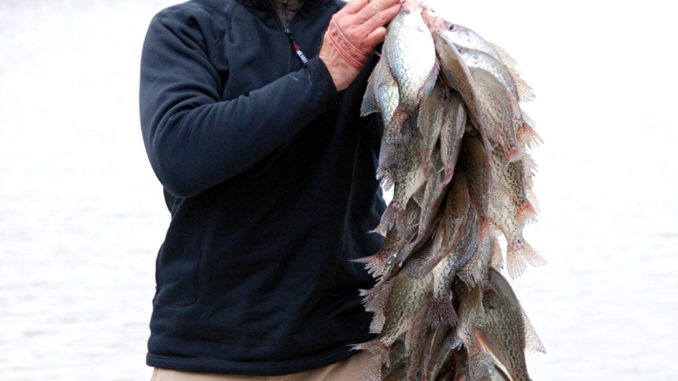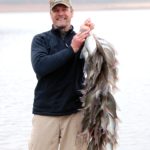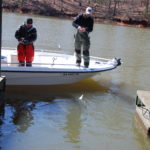
The best fishing for winter crappie in South Carolina may be in the most-obvious locations. Learn to find them.
It may seem like the dead of winter to most anglers as January slowly rolls over into February, but in the deep depths of most lakes and reservoirs across the Palmetto State, the first urges of spring spawning are beginning to bloom, which means crappie, which never go completely inactive in the winter, begin to stir.
Being in the sunfish family, crappie have generally higher metabolisms than most other fish, and when the daylight hours begin to lengthen in late winter, the popular panfish can be caught in both large sizes and generous numbers — if you know where to find them.
Normally considered a spring or summer hangout, boat docks can be a magnet for late winter crappie if they combine two important elements: deep water and structure.
Georgia native Doug Youngbood, a two-time BASS Classic qualifier turned crappie guide, loves to target deep boat docks during the winter.
Youngblood said that while most anglers spend their winter trips braving the cold in open water, massaging deep brush piles, boat docks can produce huge numbers of crappie in a more-protected environment.
“I use a sensitive, ultralight rod and slip up to the docks in my boat,” said Youngblood (770-945-0797), who does a lot of guiding on Lake Hartwell. “I prefer to target multi-slip docks that provide crappie space to move both horizontally and vertically.”
Youngblood said that crappie will often relate to docks in cold weather even better than a deep brush pile because the overhead structure works as a current break as well as providing security and an ambush point for feeding on baitfish.
“It’s the depth under the dock that attracts crappie,” he said. “If they are in the right place and have the right depth, that dock is the structure. The fish will lay in the shadows of that dock; they won’t be in the sun, they’ll be laying under that dock. That’s why I’m working to get my jigs up into the shade of those docks.”
Youngblood said that lakes with deep, clear winter water are most likely to have crappie under docks, as crappie are most prone to sight-feed in clear water. His preference is a long, marina dock or a community dock with multiple slips. A stretched-out dock gives the fish a variety of bottom depths to move up or down with the water temperatures.
“Look for those deep docks that are sitting over creek channels; some of them may be sitting right on the edge of the channel,” he said. “They’re anywhere from 10 to 60 feet deep. That’s what you want to look for in the winter, a depth range the fish can use without leaving the dock.”
Youngblood uses a mix of presentations, from casting into open bays of boat docks to shooting jigs into nooks and crannies at the backs of the docks to using a long pole to vertically jig open spots. The common factor is a tiny jig fished on light line that is allowed to fall slowly through the water column. The jig is then slowly reeled back through the water column while twitching the tip of the rod.
Youngblood’s preferred baits for his winter boat-dock fishing are a Bobby Garland Baby Shad or a Southern Pro crappie craw. He rigs these on 1/32- or 1/64-ounce jigheads so they will fall slowly and said that fishing with 4-pound test line is a must because the water is usually gin clear with all of the algae gone. Youngblood will present a double rig straight down in the deepest corners of the dock stalls and said he rarely feels the bite because crappie gently suck in the bait and don’t move. His first indication of a bite is either a slight tick in the line or it starts to pile up at the surface.
“I’m using 4-pound test,” he said. “It comes off a spinning reel real good and I’m using a 1/32-ounce leadhead. I like the Bobby Garland Baby Shad crappie jigs. You have to watch the line, both as the jig sinks and as you twitch it back to you. You’ll definitely get more strikes with that light line. You can step up to 6- or 8-, you don’t get near the bites that you’ll get with the 4-pound.”
Youngblood said some of the docks he typically fishes in the winter may have water as deep as 60 feet under them but his preference is in the 30-foot range. He suggests counting the jig down until you either get a bite or reach 25. He said that if no one is home, he’ll move over to the next stall which may only be 10 to 20 feet away.
“Crappie don’t move around much in cold water,” he said, “so if I don’t get a bite at one stall, I can move over to the next stall, and it may be covered up with fish. The good thing is that when you find a dock that produces, you can catch fish until they cut off. Even then, they’ll usually be under that same dock for several weeks until weather or water conditions change.”
Tom Mundy, the owner of Fish Stalker Lures, said the coldest weather of the year will find him hunkered down in his boat, huddled over a single fishing rod. Mundy loves bridge overpasses, especially on deep, clear lakes.
“There are three things about a bridge that crappie love,” he said. “First, there’s usually a deep channel nearby. Second, most bridges are either concrete or metal, and both of these will absorb heat from the sun and transfer it down into the water. Third is that bridges have a way of collecting underwater debris: logs and limbs and anything that floats by. This stuff gets trapped under the bridge and makes for some perfect crappie-holding cover.”
Mundy doesn’t just cast around bridge structure and move on. Once he locates a productive spot under a bridge, a place that combines deep water, columns and structure, he fishes it with the tenacity of an ice fisherman. He’s even designed his own baits to complete the tactic.
“I spent a lot of time researching a do-nothing bait that would have a lot of appeal when placed right in a crappie’s face,” said Mundy. “What I came up with was the Slab Tail jig. It’s a small body bait designed to be fished on ultra-light, 4 pound test line and a tiny, 1/64-ounce jighead.”
To present the bait, Mundy drops it to the bottom and slowly winds it up using a “do-nothing” retrieve. He claims the subtle action of the rod tip imparts a wiggling action to the bait that is often more than a dormant cold water crappie can resist.
“Crappie don’t expend a lot of energy in the winter to eat,” he said. “They may only eat once a day, but they won’t pass up an easy meal if they don’t have to work to get it. This has worked for me hundreds of times when other guys said they just weren’t biting, when I know they’re down there and I see them the on my graph. They say you can’t make them bite, but this is the next best thing.”






Be the first to comment